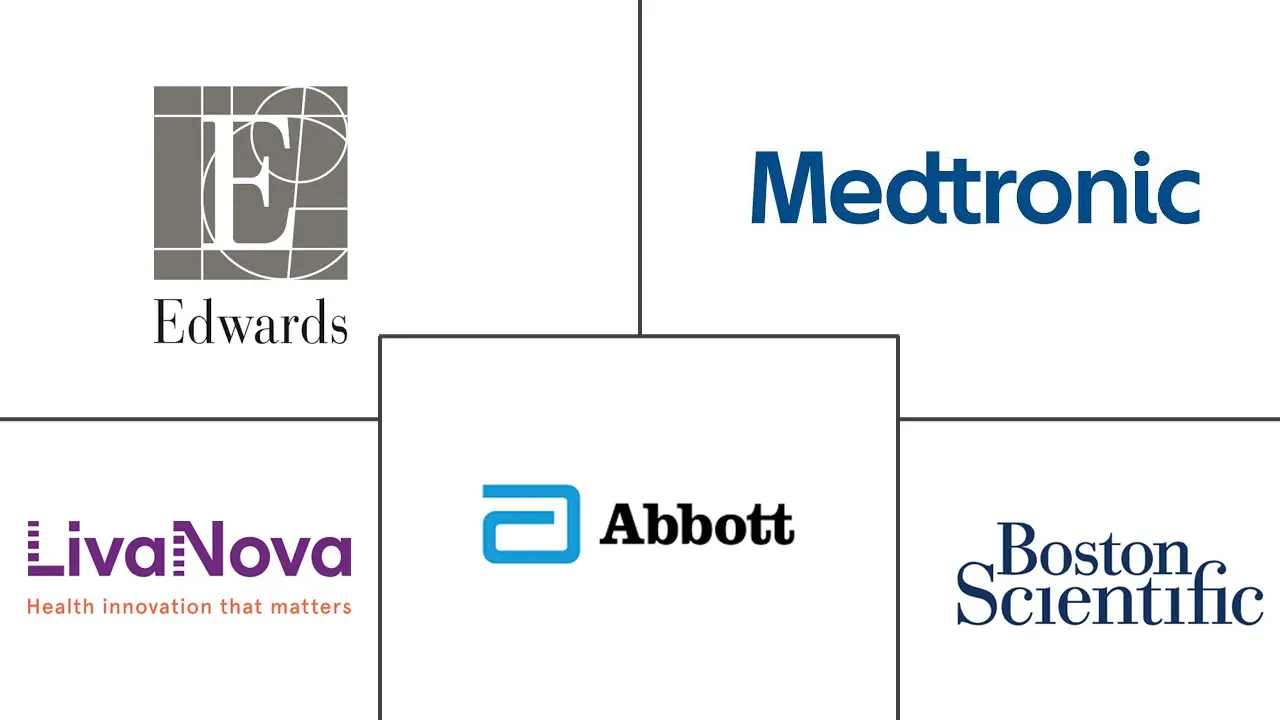Structural Heart Devices Market Size and Share
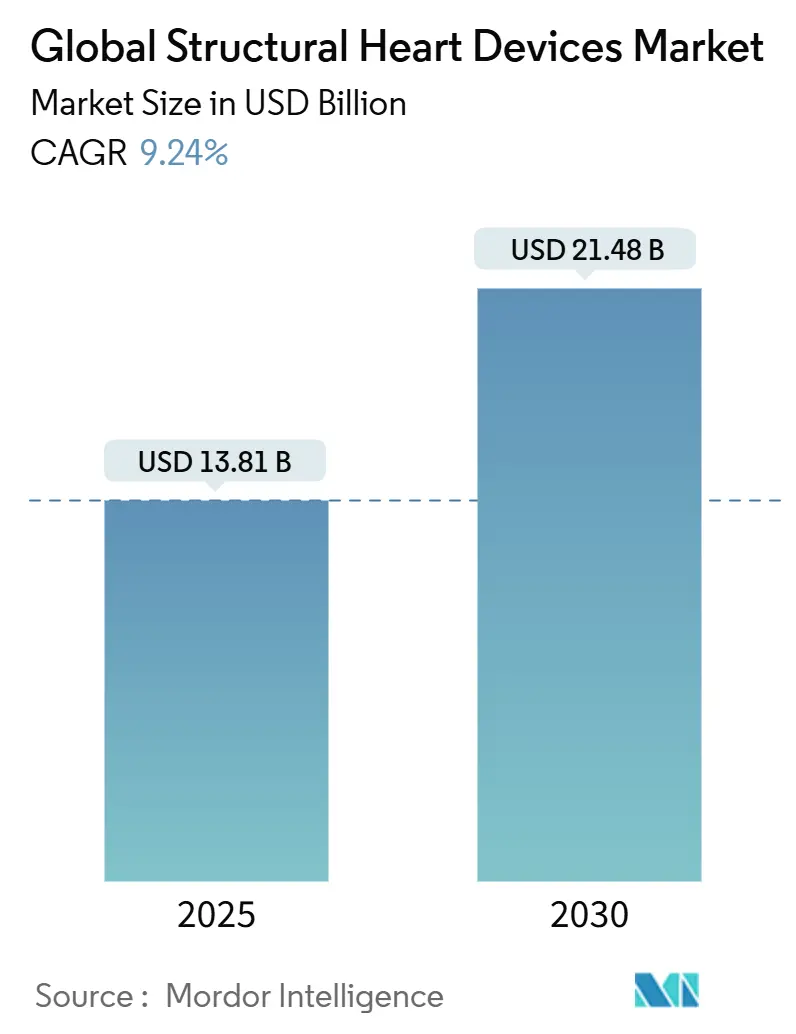
Structural Heart Devices Market Analysis by Mordor Intelligence
The structural heart devices market size stands at USD 13.81 billion in 2025 and is forecast to reach USD 21.48 billion by 2030, reflecting a 9.24% CAGR. Robust demand for transcatheter aortic valve replacement (TAVR), wider reimbursement for low-risk patients, and continuous device upgrades lift near-term growth prospects. Product launches that simplify delivery systems, rising procedure volumes in ambulatory surgical centers, and the entry of polymer-free nitinol frames also widen clinical adoption. Competition is sharpening as established suppliers race to expand mitral and tricuspid portfolios, while regional players use price advantages to penetrate emerging Asian markets. Persistent shortages of skilled interventional cardiologists and high capital costs for hybrid cath-lab/OR suites temper the overall trajectory, yet the structural heart devices market remains on a solid expansion path.
Key Report Takeaways
- By product category, heart valve devices led with 60.0% revenue share in 2024, while the “0ther products” segment is advancing at a double-digit CAGR of 12.8% through 2030 as firms diversify beyond valves.
- By procedure, replacement therapies commanded 68.0% of the structural heart devices market share in 2024, whereas transcatheter repair is projected to expand at a 14.2% CAGR to 2030.
- By end user, hospitals and cardiac centers held 83.0% of 2024 revenue, yet ambulatory surgical centers show the fastest growth at 12.5% CAGR on the back of cost savings and same-day discharge models.
- By geography, North America accounted for 40.0% of 2024 sales, while Asia-Pacific is the fastest-growing region at 11.1% CAGR as procedure volumes rise in India and China.
Global Structural Heart Devices Market Trends and Insights
Driver Impact Analysis
| Drivers Impact Analysis | (~) % Impact on CAGR Forecast | Geographic Relevance | Impact Timeline |
|---|---|---|---|
| Rising prevalence of structural heart diseases in aging populations of high-income regions | +2.8% | North America, Europe, Japan | Long term (≥ 4 years) |
| Expanding adoption of transcatheter valve therapies in low-risk patient cohorts | +2.1% | Global, early uptake in North America and Europe | Medium term (2-4 years) |
| Favorable reimbursement expansion for TAVR and TMVr procedures | +1.6% | North America, Europe, select APAC | Medium term (2-4 years) |
| Rapid innovation in next-generation biomaterials and polymer-free nitinol frames | +1.2% | Global | Medium term (2-4 years) |
| Growth of ambulatory cardiac surgery centers enabling same-day discharge | +0.9% | North America, emerging in Europe | Short term (≤ 2 years) |
| Increasing strategic partnerships between device OEMs & AI-enabled imaging firms for pre-op planning | +0.6% | North America, Europe, developed APAC | Short term (≤ 2 years) |
| Source: Mordor Intelligence | |||
Rising Prevalence of Structural Heart Diseases In Aging Populations of High-Income Regions
Longer life expectancy in developed economies has expanded the at-risk pool for calcific aortic stenosis and functional mitral regurgitation. Recent registry updates show escalating procedure volumes in patients aged ≥75 years, reinforcing a long-run demand curve. Early-intervention evidence from the EARLY TAVR trial indicates a 20% reduction in rehospitalizations when asymptomatic severe aortic stenosis is treated before symptom onset, broadening the potential candidate base[1]Edwards Lifesciences, “2024 Annual Report,” edwards.com.
Expanding Adoption of Transcatheter Valve Therapies in Low-Risk Patient Cohorts
Five-year follow-up of low-risk patients confirms comparable all-cause mortality between TAVR and surgery, accelerating payer and clinician confidence[2]John K. Forrest et al., “5-Year Outcomes After Transcatheter or Surgical Aortic Valve Replacement in Low-Risk Patients,” Journal of the American College of Cardiology, jacc.org. Commercial focus has therefore moved to valve durability, paravalvular leak reduction, and hemodynamic performance. Edwards maintains roughly 60% share, Medtronic 28%, and newer entrants such as Abbott are gaining traction with the Navitor system, intensifying differentiation battles.
Favorable Reimbursement Expansion for TAVR And TMVr Procedures
CMS updated its National Coverage Determination to ease data-collection criteria for low-risk TAVR patients, while select European payers now reimburse transcatheter mitral repair outside tertiary centers[3]Centers for Medicare & Medicaid Services, “National Coverage Determination for Transcatheter Aortic Valve Replacement,” cms.gov. Bundled-payment experiments promote efficient device pricing, nudging OEMs toward cost-effective delivery kits and single-use accessory consolidation.
Growth Of Ambulatory Cardiac Surgery Centers Enabling Same-Day Discharge
ASCs handle an increasing mix of left atrial appendage closure and patent foramen ovale repair. Medicare analyses show stroke and mortality below 1% in ASC cohorts, supporting further migration of select valve-in-valve procedures to outpatient settings. Device makers are responding with shorter shaft catheters and simplified sealing mechanisms tailored to resource-constrained facilities.
Increasing Strategic Partnerships Between Device OEMs and AI-Enabled Imaging Firms for Pre-Op Planning
Philips and GE HealthCare have embedded automated 3D quantification into cardiovascular ultrasound, reducing assessment time for tricuspid regurgitation. Improved sizing accuracy limits paravalvular leak, prompting OEMs to bundle imaging analytics with valve systems in value-based contracts.
Restraints Impact Analysis
| Restraints Impact Analysis | (~) % Impact on CAGR Forecast | Geographic Relevance | Impact Timeline |
|---|---|---|---|
| Limited access to skilled interventional cardiologists in emerging Asia & Africa | −1.8% | Asia-Pacific (excluding Japan, South Korea), Africa, Latin America | Medium term (2-4 years) |
| High up-front capital expenditure for hybrid cath-lab/OR suites constraining smaller hospitals | −1.4% | Global, higher impact in emerging markets | Medium term (2-4 years) |
| Durability concerns & re-intervention needs with certain transcatheter valves | −0.9% | Global | Long term (≥ 4 years) |
| Supply-chain volatility of medical-grade nitinol & PET raising production costs | −0.7% | Global, higher impact on smaller manufacturers | Short term (≤ 2 years) |
| Source: Mordor Intelligence | |||
Limited Access to Skilled Interventional Cardiologists In Emerging Asia & Africa
Rheumatic heart disease remains common in lower-income parts of Asia and Africa, yet procedure capacity is locked in metropolitan hubs. Complex transcatheter mitral replacement requires extensive proctoring that cannot be scaled quickly. Industry training collaborations are underway, but the supply gap continues to dampen adoption momentum in regions with the highest latent demand.
High Up-Front Capital Expenditure for Hybrid Cath-Lab/Or Suites Constraining Smaller Hospitals
Hospitals face negative contribution margins of roughly USD 3,380 per TAVR episode versus positive margins for surgery, discouraging uptake outside high-volume centers[4]American Heart Association Journals, “Economic Considerations in Access to Transcatheter Aortic Valve Replacement,” ahajournals.org. Financing solutions such as revenue-share models and mobile cath-lab units are emerging, yet progress remains gradual.
Segment Analysis
By Product: Heart Valve Devices Lead as Occluders Accelerate
Heart valve devices captured 60.0% of 2024 revenue, confirming their anchor role in the structural heart devices market. TAVR’s worldwide revenue is approaching USD 7.0 billion, supported by 10.0% annual growth in the United States. Valve developers focus on lower profile delivery, anti-calcification leaflets, and commissural alignment technologies that improve long-term durability. The structural heart devices market size for valve platforms is projected to advance in lockstep with the rollout of next-generation systems such as Edwards SAPIEN M3, the first transfemoral mitral replacement to secure a CE Mark in 2025.
Occluders and delivery systems are witnessing rapid procedural expansion, particularly in stroke-prevention applications. Abbott’s WATCHMAN FLX portfolio continues to gain operator confidence due to pivot-ready frames and full-circumference sealing. Sales growth is amplified by favorable outpatient reimbursement, making occluders the quickest expanding sub-category within transcatheter repair solutions. New polymer-free nitinol iterations promise even shorter in-hospital stays, placing additional upward pressure on adoption curves across secondary prevention populations. Collectively, these trends maintain the structural heart devices market on its high-single-digit trajectory.
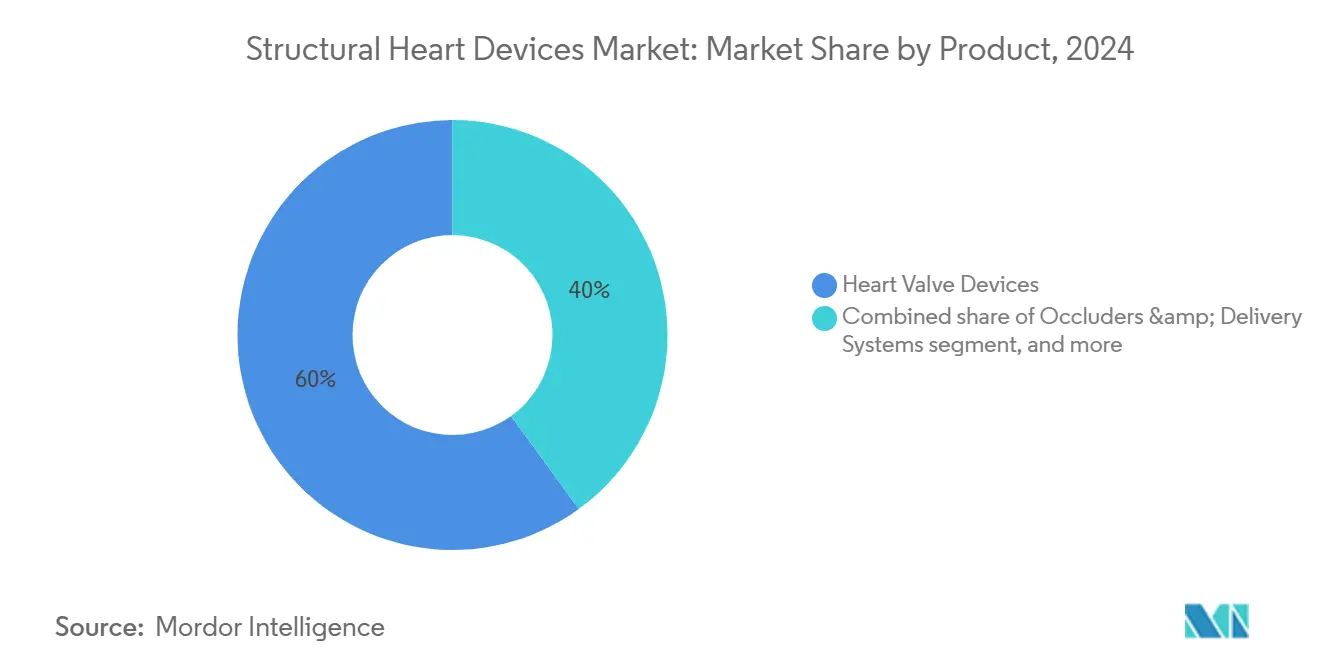
Note: Segment shares of all individual segments available upon report purchase
By Procedure: Transcatheter Repair Disrupts Replacement Dominance
Replacement therapies retained 68.0% share in 2024, helped by robust evidence in low-risk patients and consistent reimbursement across North America and Europe. The structural heart devices market share for TAVR alone is projected to widen further as valve-in-valve and bicuspid approvals unlock new patient cohorts. Edwards estimates 5%–7% TAVR revenue growth for 2025, reaching up to USD 4.4 billion.
Transcatheter repair, steered by clip-based mitral and tricuspid systems, is the structural heart devices market’s fastest-growing procedural class at a 14.2% CAGR. Abbott’s MitraClip generation IV shows reduced residual MR and durable symptomatic relief, underpinning more than 20 supporting trials. FDA clearance of the TriClip and the CE-marked EVOQUE tricuspid valve extend repair technology into previously untreated anatomy, rapidly diversifying manufacturer revenue. This momentum broadens the structural heart devices market size for repair solutions and repositions replacement as one of several viable options rather than the default.
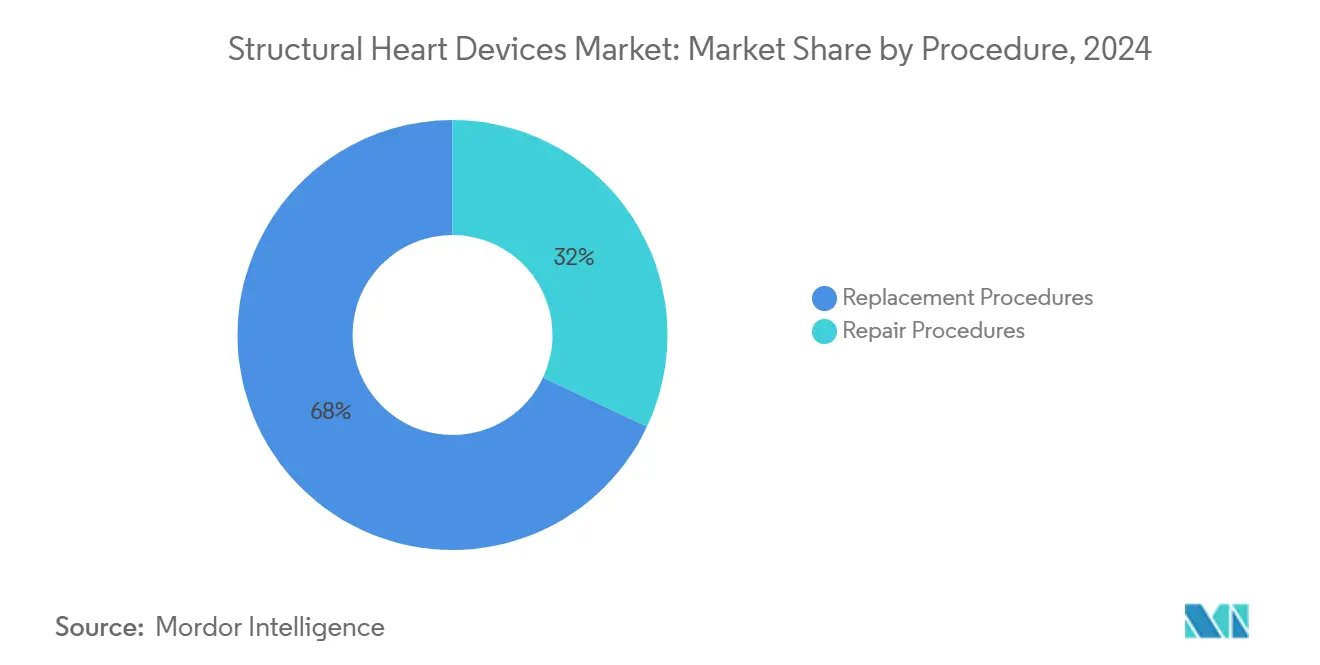
Note: Segment shares of all individual segments available upon report purchase
By End User: Ambulatory Centers Challenge Hospital Dominance
Hospitals and cardiac centers delivered 83.0% of global procedures in 2024, leveraging critical-care capability for complex multivalve interventions. Institutions with dedicated structural heart programs report procedure volume growth of 84% for TAVR/TEER during the 2020–2024 window, underscoring continued centrality of acute-care settings. Yet fixed-cost intensity fuels consolidation, and hospital operators are preparing for a future in which higher-margin elective work migrates off-campus.
Ambulatory surgical centers captured 17.0% of procedures in 2024 but are expanding at 12.5% CAGR. Medicare data show low adverse-event rates, supporting payer confidence and prompting scheduling shifts toward same-day discharge models. Device firms now tailor valve kits with shorter sheaths and pre-mounted delivery handles that can be deployed without full hybrid OR capability. The result is a structural heart devices market dynamic in which ASCs accelerate competitive pricing pressure while expanding patient access, especially for left atrial appendage and PFO closures.
Geography Analysis
North America generated 40.0% of global revenue in 2024, anchored by the United States, which performs more than half of all TAVR implants worldwide and maintains roughly 10.0% annual procedure growth. CMS coverage expansion and ASC penetration underpin continued double-digit growth in transcatheter repair volumes. Canadian reimbursement reforms for mitral clip procedures add incremental upside through 2027.
Europe ranks second in value and adopts new technologies swiftly because of centralized procurement and pan-regional CE approvals. The April 2025 CE Mark of the SAPIEN M3 highlights the region’s role as an early commercialization hub for transfemoral mitral solutions. Hospital networks in Germany and France are broadening clip labs and triaging patients into minimally invasive pathways, helping the structural heart devices market size in Europe maintain mid-single-digit growth despite demographic plateauing.
Asia-Pacific posts the fastest CAGR at 11.1% through 2030 as procedure volumes accelerate in China, Australia, and India. India’s structural heart segment, only USD 12.4 million in 2024, is on track for 31% CAGR, driven by domestic OEMs and tier-two private hospitals expanding cath-lab capacity. Diverse disease profiles create varied clinical priorities, from rheumatic-related mitral repair demand in rural areas to degenerative aortic stenosis in urban centers, requiring differentiated go-to-market strategies. Japan’s aging population continues to underpin steady TAVR growth, while South-Korean tertiary centers pilot AI-guided sizing for mitral interventions.
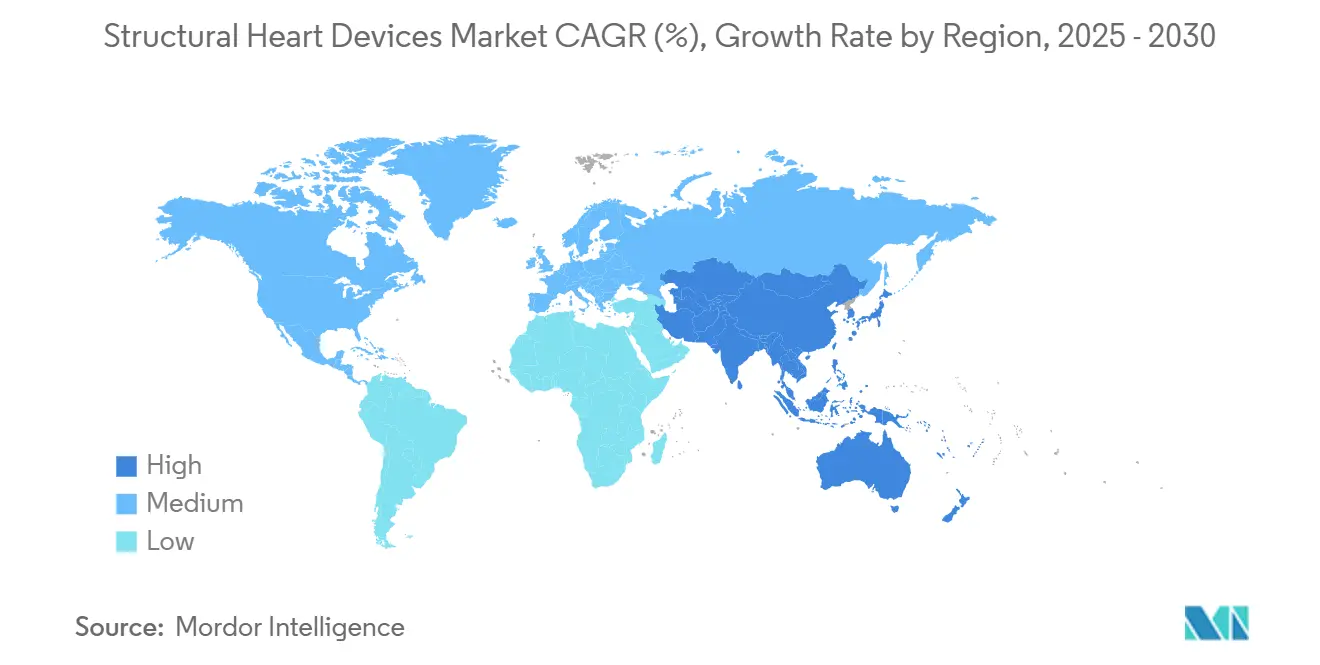
Competitive Landscape
The structural heart devices market shows moderate concentration, with Abbott Laboratories, Medtronic plc, and Edwards Lifesciences Corporation accounting for slightly more than 70.0% of 2024 revenue. Abbott’s structural heart unit posted 22.6% sales growth in Q4 2024, reaching USD 2.25 billion on the back of MitraClip expansions and the Navitor aortic system. Edwards forecasts USD 500–530 million in 2025 TMTT revenue, a 50–60% jump that underscores the strategic pivot toward multivalve portfolios.
Medtronic leverages its CoreValve lineage and Evolut FX platform to capture low-profile implant share, while preparing for future Symphony mitral and Intrepid transcatheter mitral replacement programs. Boston Scientific exited TAVR after withdrawal of Acurate neo2, reallocating capital toward left atrial appendage and stroke-prevention devices.
Midsize suppliers pursue capability gaps through acquisitions. Integer Holdings spent USD 152 million on Precision Coating in 2025 to access surface-coating IP that can reduce leaflet thrombosis. OEMs also sign co-development deals with imaging vendors to lock in AI-driven sizing algorithms, weaving procedural guidance into value propositions. Clinical-evidence arms races remain critical; Abbott runs more than 20 structural heart trials, while Edwards sponsors long-term durability registries to substantiate resin-infused leaflet benefits.
Structural Heart Devices Industry Leaders
-
Abbott Laboratories
-
Medtronic plc
-
Edwards Lifesciences Corporation
-
Boston Scientific Corporation
-
LivaNova PLC
- *Disclaimer: Major Players sorted in no particular order

Recent Industry Developments
- May 2025: Abbott received FDA approval for its Tendyne transcatheter mitral valve replacement system, offering a surgical alternative for severe mitral annular calcification.
- May 2025: Boston Scientific discontinued global sales of its Acurate neo2 and Acurate Prime TAVR systems after failing to secure FDA approval, reshaping competitive positioning.
- April 2025: Edwards Lifesciences received CE Mark for SAPIEN M3, the first transfemoral transcatheter mitral valve replacement system.
- April 2025: UPMC Heart and Vascular Institute completed the first U.S. valve-in-valve TAVR with the ShortCut device, mitigating coronary obstruction risk during leaflet laceration.
- February 2025: Integer Holdings acquired Precision Coating to integrate advanced surface treatments into cardiovascular portfolios.
Research Methodology Framework and Report Scope
Market Definitions and Key Coverage
Our study defines the structural heart devices market as all commercially approved implantable or transcatheter products that repair or replace cardiac valves or close septal and appendage defects; accessory imaging consoles and extracorporeal heart-pump systems are kept outside the valuation.
Scope Exclusion: Standalone diagnostic imaging platforms and ventricular assist pumps are not covered by this analysis.
Segmentation Overview
- By Product
- Heart Valve Devices (TAVR, TMVR, Surgical)
- Occluders & Delivery Systems (ASD, VSD, PDA, LAA)
- Annuloplasty & Support Rings
- Other Products
- By Procedure
- Replacement Procedures
- Repair Procedures
- By End User
- Hospitals & Cardiac Centers
- Ambulatory Surgical Centers
- Other End-Users
- Geography
- North America
- United States
- Canada
- Mexico
- Europe
- Germany
- United Kingdom
- France
- Italy
- Spain
- Rest of Europe
- Asia-Pacific
- China
- Japan
- India
- South Korea
- Australia
- Rest of Asia-Pacific
- Middle-East and Africa
- GCC
- South Africa
- Rest of Middle East and Africa
- South America
- Brazil
- Argentina
- Rest of South America
- North America
Detailed Research Methodology and Data Validation
Primary Research
Cardio-thoracic surgeons, interventional cardiologists, procurement managers, and payor reviewers across North America, Europe, and key Asia-Pacific markets shared insights on TAVR, TMVR, LAAC penetration rates, average selling prices, and learning-curve utilization trends, letting us fine-tune assumptions before final triangulation.
Desk Research
Mordor analysts first screen authoritative public sources such as the American Heart Association, Centers for Medicare & Medicaid Services, World Health Organization, Eurostat surgery files, and major cardiology journals for prevalence, procedure, and reimbursement statistics. Regulatory registries (FDA PMA, CE-Mark), customs-level trade codes, and company 10-Ks then help translate procedure counts into shipment-level device flows. Subscription content from D&B Hoovers and Dow Jones Factiva supplies segmented revenue splits that are realigned to our product taxonomy. The sources cited are illustrative; numerous additional open and paid datapoints supported validation and clarification.
Market-Sizing & Forecasting
We anchor the baseline using a top-down reconstruction of global TAVR, SAVR, mitral repair, and occluder procedure volumes matched with weighted ASPs. We then corroborate totals with a selective bottom-up supplier roll-up. Key variables include aortic-stenosis prevalence, low-risk TAVR adoption, regulatory approval cadence, reimbursement coverage ratios, and device ASP deflation. A multivariate regression on these drivers, layered with GDP-weighted aging curves, produces the outlook, while scenario analysis handles policy-driven volume swings.
Data Validation & Update Cycle
Outputs undergo variance checks against hospital discharge datasets, quarterly manufacturer revenues, and trade shipments. Senior reviewers resolve anomalies before sign-off, and the model refreshes annually or sooner if material events occur so clients always receive the latest view.
Why Mordor's Structural Heart Devices Baseline Commands Reliability
Published estimates often diverge because research groups mix product baskets, data vintages, and currency conversions.
Key gap drivers include whether occlusion devices are counted, the aggressiveness of TAVR ASP erosion, and how emerging-market volumes are evidenced.
Benchmark comparison
| Market Size | Anonymized source | Primary gap driver |
|---|---|---|
| USD 13.81 B (2025) | Mordor Intelligence | |
| USD 16.31 B (2024) | Global Consultancy A | Includes accessories and imaging consoles; limited bottom-up validation |
| USD 12.30 B (2024) | Regional Consultancy B | Excludes LAAC segment and uses constant 2023 ASPs for forecasts |
The comparison shows how broader scope or static pricing inflates or deflates totals, whereas Mordor's disciplined segmentation, annual refresh, and dual-path validation deliver a balanced, decision-ready baseline for stakeholders.
Key Questions Answered in the Report
What is the current value of the structural heart devices market?
The structural heart devices market size stands at USD 13.81 billion in 2025 and is forecast to reach USD 21.48 billion by 2030.
Which product segment generates the largest revenue?
Heart valve devices dominate with 60.0% of 2024 revenue, underpinned by sustained TAVR growth.
How fast are transcatheter repair procedures growing?
Transcatheter repair, including MitraClip and TriClip, is expanding at a 14.2% CAGR through 2030, making it the fastest-growing procedural class.
Why are ambulatory surgical centers important to future growth?
ASCs provide cost-effective, same-day discharge pathways and are growing at 12.5% CAGR, shifting demand away from traditional hospital settings.
Which region shows the highest growth potential?
Asia-Pacific leads with an 11.1% forecast CAGR, propelled by rising procedure volumes in China and India.
Who are the major players in this market?
Abbott Laboratories, Medtronic plc, Edwards Lifesciences Corporation lead with a combined share above 70.0%, supported by broad portfolios and extensive clinical evidence programs.
Page last updated on:
